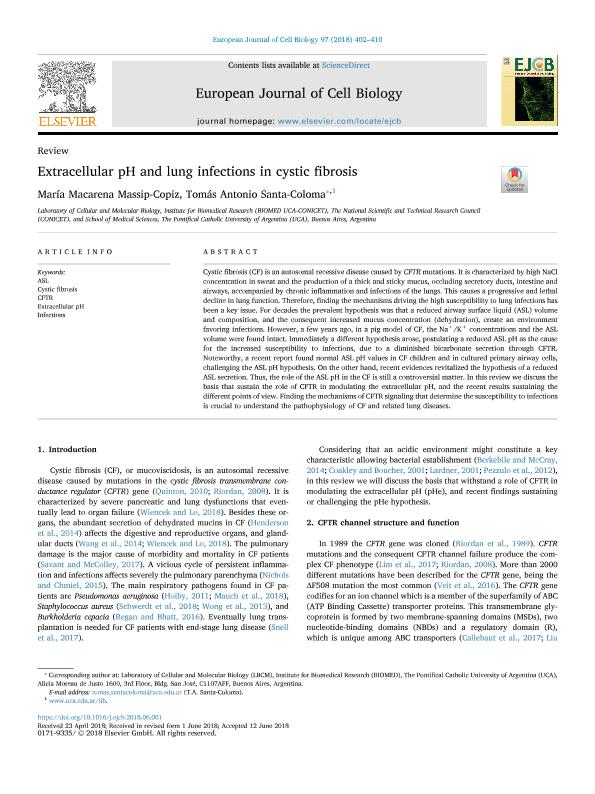Mostrar el registro sencillo del ítem
dc.contributor.author
Massip Copiz, María Macarena

dc.contributor.author
Santa Coloma, Tomás Antonio

dc.date.available
2020-03-06T15:56:32Z
dc.date.issued
2018-08
dc.identifier.citation
Massip Copiz, María Macarena; Santa Coloma, Tomás Antonio; Extracellular pH and lung infections in cystic fibrosis; Elsevier Gmbh; European Journal Of Cell Biology; 97; 6; 8-2018; 402-410
dc.identifier.issn
0171-9335
dc.identifier.uri
http://hdl.handle.net/11336/98926
dc.description.abstract
Cystic fibrosis (CF) is an autosomal recessive disease caused by CFTR mutations. It is characterized by high NaCl concentration in sweat and the production of a thick and sticky mucus, occluding secretory ducts, intestine and airways, accompanied by chronic inflammation and infections of the lungs. This causes a progressive and lethal decline in lung function. Therefore, finding the mechanisms driving the high susceptibility to lung infections has been a key issue. For decades the prevalent hypothesis was that a reduced airway surface liquid (ASL) volume and composition, and the consequent increased mucus concentration (dehydration), create an environment favoring infections. However, a few years ago, in a pig model of CF, the Na+/K+ concentrations and the ASL volume were found intact. Immediately a different hypothesis arose, postulating a reduced ASL pH as the cause for the increased susceptibility to infections, due to a diminished bicarbonate secretion through CFTR. Noteworthy, a recent report found normal ASL pH values in CF children and in cultured primary airway cells, challenging the ASL pH hypothesis. On the other hand, recent evidences revitalized the hypothesis of a reduced ASL secretion. Thus, the role of the ASL pH in the CF is still a controversial matter. In this review we discuss the basis that sustain the role of CFTR in modulating the extracellular pH, and the recent results sustaining the different points of view. Finding the mechanisms of CFTR signaling that determine the susceptibility to infections is crucial to understand the pathophysiology of CF and related lung diseases.
dc.format
application/pdf
dc.language.iso
eng
dc.publisher
Elsevier Gmbh

dc.rights
info:eu-repo/semantics/openAccess
dc.rights.uri
https://creativecommons.org/licenses/by-nc-nd/2.5/ar/
dc.subject
ASL
dc.subject
CFTR
dc.subject
CYSTIC FIBROSIS
dc.subject
EXTRACELLULAR PH
dc.subject
INFECTIONS
dc.subject.classification
Biología Celular, Microbiología

dc.subject.classification
Ciencias Biológicas

dc.subject.classification
CIENCIAS NATURALES Y EXACTAS

dc.title
Extracellular pH and lung infections in cystic fibrosis
dc.type
info:eu-repo/semantics/article
dc.type
info:ar-repo/semantics/artículo
dc.type
info:eu-repo/semantics/publishedVersion
dc.date.updated
2020-03-05T14:57:07Z
dc.journal.volume
97
dc.journal.number
6
dc.journal.pagination
402-410
dc.journal.pais
Alemania

dc.journal.ciudad
Berlin
dc.description.fil
Fil: Massip Copiz, María Macarena. Pontificia Universidad Católica Argentina "Santa María de los Buenos Aires". Instituto de Investigaciones Biomédicas. Consejo Nacional de Investigaciones Científicas y Técnicas. Oficina de Coordinación Administrativa Houssay. Instituto de Investigaciones Biomédicas; Argentina
dc.description.fil
Fil: Santa Coloma, Tomás Antonio. Pontificia Universidad Católica Argentina "Santa María de los Buenos Aires". Instituto de Investigaciones Biomédicas. Consejo Nacional de Investigaciones Científicas y Técnicas. Oficina de Coordinación Administrativa Houssay. Instituto de Investigaciones Biomédicas; Argentina
dc.journal.title
European Journal Of Cell Biology

dc.relation.alternativeid
info:eu-repo/semantics/altIdentifier/url/https://www.sciencedirect.com/science/article/pii/S0171933518301481
dc.relation.alternativeid
info:eu-repo/semantics/altIdentifier/doi/http://dx.doi.org/10.1016/j.ejcb.2018.06.001
Archivos asociados
